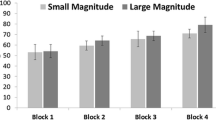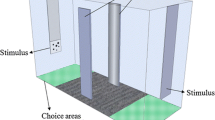Abstract
Non-verbal numerical behavior in human infants, human adults, and non-human primates appears to be rooted in two distinct mechanisms: a precise system for tracking and comparing small numbers of items simultaneously (up to 3 or 4 items) and an approximate system for estimating numerical magnitude of a group of objects. The most striking evidence that these two mechanisms are distinct comes from the apparent inability of young human infants and non-human primates to compare quantites across the small (<3 or 4)/large (>4) number boundary. We ask whether this distinction is present in lower animal species more distantly related to humans, guppies (Poecilia reticulata). We found that, like human infants and non-human primates, fish succeed at comparisons between large numbers only (5 vs. 10), succeed at comparisons between small numbers only (3 vs. 4), but systematically fail at comparisons that closely span the small/large boundary (3 vs. 5). Furthermore, increasing the distance between the small and large number resulted in successful discriminations (3 vs. 6, 3 vs. 7, and 3 vs. 9). This pattern of successes and failures is similar to those observed in human infants and non-human primates to suggest that the two systems are present and functionally distinct across a wide variety of animal species.


Similar content being viewed by others
Notes
Data from the two samples of the 3 versus 5 comparison were pooled and entered into the ANOVA, given the two groups showed no significant differences, data had a normal distribution (Kolmogorov–Smirnov one sample t test, P > 0.1), and no difference between groups was found in the variance (Leven test, P > 0.05).
We also ran an ANOVA on the weighted means to account for the difference in the number of subjects in each group (n = 36 for 3 vs. 5, n = 18 for 3 vs. 4, n = 18 for 5 vs. 10). The analysis of the weighted means produced parallel results to those obtained on the raw scores. Specifically, when we compared 3 versus 4 and 3 versus 5, we observed a significant main effect of Number (F(1,52) = 4.703, P = 0.036) and a significant interaction between Number and Contrast (F(1,52) = 5.504, P = 0.021). The main effect of Contrast was not significant (F(1,52) = 1.181, P = 0.278). When comparing 3 versus 5 and 5 versus 10, we found a significant main effect of Number (F(1,52) = 5.684, P = 0.020) and a significant interaction between Number and Contrast (F(1,52) = 4.902, P = 0.036). Again, the main effect of Contrast alone was not significant (F(1,52) = 0.011, P = 0.920).
References
Agrillo C, Dadda M (2007) Discrimination of the larger shoal in the poeciliid fish Girardinus falcatus. Ethol Ecol Evol 19:145–157
Agrillo C, Dadda M, Bisazza A (2007) Quantity discrimination in female mosquitofish. Anim Cogn 10:63–70
Agrillo C, Dadda M, Serena G, Bisazza A (2008) Do fish count? Spontaneous discrimination of quantity in female mosquitofish. Anim Cogn 11(3):495–503
Agrillo C, Piffer L, Bisazza A (2010) Large number discrimination by fish. PLoS ONE 5(12):e15232. doi:10.1371/journal.pone.0015232
Agrillo C, Piffer L, Bisazza A (2011) Number versus continuous quantity in numerosity judgments by fish. Cognition 119:281–287
Al Aïn S, Giret N, Grand M, Kreutzer M, Bovet D (2009) The discrimination of discrete and continuous amounts in African grey parrots (Psittacus erithacus). Anim Cogn 12:145–154
Ansari D, Lyons I, van Eimeren L, Xu F (2007) Linking visual attention and number processing in the brain: the role of the temporo-parietal junction in small and large non-symbolic number comparison. J Cogn Neurosci 19:1845–1853
Barth H (2008) Judgments of discrete and continuous quantity: an illusory Stroop effect. Cognition 109(2):251–266
Bisazza A, Piffer L, Serena G, Agrillo C (2010) Ontogeny of numerical abilities in fish. PLoS ONE 5(11):e15516. doi:10.1371/journal.pone.0015516
Bradner J, McRobert SP (2001) The effect of shoal size on patterns of body colour segregation in mollies. J Fish Biol 59(4):960–967
Brannon EM, Terrace HS (2000) Representation of the numerosities 1–9 by rhesus macaques (Macaca mulatta). J Exp Psych Anim Behav Proc 26(1):31–49
Buckingham JN, Wong BBM, Rosenthal GG (2007) Shoaling decisions in female swordtails: how do fish gauge group size? Behaviour 144:1333–1346
Cantlon JF, Brannon EM (2006) Shared system for ordering small and large numbers in monkeys and humans. Psychol Sci 17(5):401–406
Carey S (2009) The origin of concepts. Oxford University Press, New York
Cordes S, Brannon EM (2008) Quantitative competencies in infancy. Dev Sci 11:803–808
Cordes S, Brannon EM (2009) Crossing the divide: infants discriminate small from large numerosities. Dev Psych 45:1583–1594
Cordes S, Gelman R, Gallistel CR, Whalen J (2001) Variability signatures distinguish verbal from nonverbal counting for both large and small numbers. Psych Bull Rev 8:698–707
Dadda M, Piffer L, Agrillo C, Bisazza A (2009) Spontaneous number representation in mosquitofish. Cognition 112:343–348
Dehaene S (1997) The number sense. Oxford University Press, Cambridge
Feigenson L (2007) The equality of quantity. Trends Cogn Sci 11(5):185–187
Feigenson L, Carey S (2003) Tracking individuals via object-files: evidence from infants’ manual search. Dev Sci 6:568–584
Feigenson L, Carey S (2005) On the limits of infants’ quantification of small object arrays. Cognition 97:295–313
Feigenson L, Carey S, Hauser MD (2002) The representations underlying infants’ choice of more: object files versus analog magnitudes. Psychol Sci 13:150–156
Feigenson L, Dehaene S, Spelke ES (2004) Core systems of number. Trends Cogn Sci 8:307–314
Gallistel CR (1990) Representations in animal cognition: an introduction. Cognition 37:1–22
Gómez-Laplaza LM, Gerlai R (2011a) Can angelfish (Pterophyllum scalare) count? Discrimination between different shoal sizes follows Weber’s law. Anim Cogn 14(1):1–9
Gómez-Laplaza LM, Gerlai R (2011b) Spontaneous discrimination of small quantities: shoaling preferences in angelfish (Pterophyllum scalare). Anim Cogn 14(4):565–574
Hauser MD, Carey S, Hauser LB (2000) Spontaneous number representation in semi-free-ranging rhesus monkeys. Proc R Soc Lond B 267:829–833
Hennig M (1977) Counting ability in Blennius-pavo Risso (Blenniidae, Perciformes). Zool Anz 199:1–18
Hunt S, Low J, Burns KC (2008) Adaptive numerical competency in a food-hoarding songbird. Proc R Soc Lond B 275:2373–2379
Hyde DC, Spelke ES (2009) All numbers are not equal: an electrophysiological investigation of small and large number representations. J Cogn Neurosci 21:1039–1053
Hyde DC, Wood JN (2011) Spatial attention determines the nature of non-verbal numerical cognition. J Cogn Neurosci 23:2336–2351
Izard V, Sann C, Spelke ES, Streri A (2009) Newborn infants perceive abstract numbers. Proc Nat Acad Sci USA 106:10382–10385
Kahneman D, Treisman A, Gibbs BJ (1992) The reviewing of object files: object-specific integration of information. Cogn Psych 24:175–219
Ledesma JM, McRobert SP (2008) Shoaling in juvenile guppies: the effects of body size and shoal size. Behav Process 77(3):384–388
Meck WH, Church RM (1983) A mode control model of counting and timing processes. J Exp Psych Anim Behav Proc 9:320–334
Moyer RS, Landauer TK (1967) The time required for judgments of numerical inequality. Nature 215:1519–1520
Pritchard VL, Lawrence J, Butlin RK, Krause J (2001) Shoal choice in zebrafish, Danio rerio: the influence of shoal size and activity. Anim Behav 62:1085–1088
Scholl BJ, Pylyshyn ZW (1999) Tracking multiple items through occlusion: clues to visual objecthood. Cogn Psych 38:259–290
Sokal RR, Rohlf FJ (1995) Biometry. Freeman and Company, New York
Trick LM, Pylyshyn ZW (1994) Why are small and large numbers enumerated differently? A limited-capacity preattentive stage in vision. Psych Rev 101:80–102
Uller C, Jaeger R, Guidry G, Martin C (2003) Salamanders (Plethodon cinereus) go for more: rudiments of number in an amphibian. Anim Cogn 6:105–112
Vallortigara G, Regolin L, Chiandetti C, Rugani R (2010) Rudiments of mind: insights through the chick model on number and space cognition in animals. Comp Cogn Behav Rev 5:78–99
Walsh V (2003) A theory of magnitude: common cortical metrics of time, space and quantity. Trends Cogn Sci 7:483–488
Ward C, Smuts BB (2007) Quantity-based judgments in the domestic dog (Canis lupus familiaris). Anim Cogn 10:71–80
Xu F (2003) Numerosity discrimination in infants: evidence for two systems of representations. Cognition 89:B15–B25
Xu F, Spelke ES (2000) Large number discrimination in 6-month-old infants. Cognition 74:B1–B11
Acknowledgments
The authors would like to thank Sonia Betti for their help conducting the experiments, and the four anonymous referees for useful comments. This study was supported by research grant from University of Padova to Christian Agrillo (‘Progetto Giovani’ 2010). The reported experiments comply with all the laws of the country (Italy) in which they were performed.
Author information
Authors and Affiliations
Corresponding author
Rights and permissions
About this article
Cite this article
Piffer, L., Agrillo, C. & Hyde, D.C. Small and large number discrimination in guppies. Anim Cogn 15, 215–221 (2012). https://doi.org/10.1007/s10071-011-0447-9
Received:
Revised:
Accepted:
Published:
Issue Date:
DOI: https://doi.org/10.1007/s10071-011-0447-9




